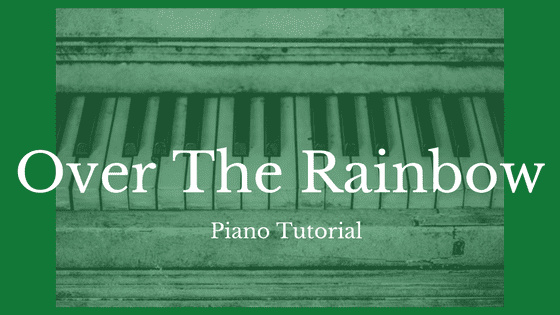'Over the Rainbow' Piano Tutorial

This article, featuring an 'Over the Rainbow' piano tutorial, will focus on a few harmonic concepts based on this beautiful song to help you achieve that advanced piano sound. We'll look at ways to take a lead sheet (fakebook or Real Book version) and add chord tones and extensions to create the same sound as the jazz piano pros. We'll also look at a common device used to resolve dominant 7 sus4 chords.
The Original Melody and Harmony
Let's take a look at the lead sheet version of the first four measures of 'Over the Rainbow':
Using this information we could simply play the melody as written with our right hand, and the corresponding chord in our left hand. Doing so would look like this:
This is a great way to start playing and working through the song as it gets you playing all of the chord tones in time with the melody, but we're going to build this arrangement into a much denser, more robust, two-handed piano arrangement.
Spreading the Voicings Across Two Hands and Adding Extensions
Now we're going to build the chords across both hands and add in some other tones, such as 9ths, 11ths, and 13ths, as well as the dominant 7 sus4 chord. Doing so might result in something like this:
Measure 1:
The Eb chord on beat 1 is pretty straightforward - it's basically just an Eb major triad with a 9th (the 'F') in the left hand. The C minor chord on beat 3 is also fairly simple. The left hand uses a shell voicing (root, 5th, 7th) and the right hand plays the 11th, 7th, and 3rd (F, Bb, Eb). One noteworthy thing about the C minor chord is that the right hand voicing is stacked in 4ths, a very jazzy sound.
Measure 2:
The G minor chord on beat 1 of measure 2 has a moving melody, unlike measure 1 in which the melody stays still. We harmonized the melody in 3rds, while the left hand plays and holds the root, 11th, 7th (G, C, F). Beat 4 is where we first use the dominant 7 sus4 chord, resolving it to the dominant 7 chord. This is a great-sounding jazz device that pro players use quite often - and it's really effective! On beat 4 we're playing the root, 4th, 7th in the left hand (Eb, Ab, Db). The right hand plays the 9th, 4th, 13th, root (F, Ab, C, Eb). There's a ton of great harmony in that chord. But it only stays there for half a beat before it resolves to the regular dominant chord on the second half of beat 4. That chord includes (from bottom up) the root, 3rd, 7th, flat-9th (E natural), 3rd, 13th (C), and root. Notice that the notes which remain constant are tied over.
Measure 3:
Again, the Ab major chord is pretty straightforward. The D7sus4 to D7 chord uses the same approach described on the Eb chord in measure 2.
Measure 4:
Here we see another advanced jazz device in which an inner voice moves within a series of chords. The G-natural on beat 1 moves down in half-steps. The harmony also follows this moving voice from G minor to G minor (major 7), and then on beats 3 and 4 we use the same dominant 7 sus4 resolution that we saw in measures 2 and 3.
For more, check out the full lesson and arrangement of Over the Rainbow!


